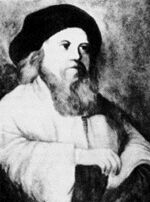 Israel ben Eliezer, born in 1700 in Podolia (in present day Ukraine) was the founder and first leader of the Hasidic movement. He came to be known as the Baal Shem Tov (Master of the Good Name) which is frequently abbreviated Besht.
Israel ben Eliezer, born in 1700 in Podolia (in present day Ukraine) was the founder and first leader of the Hasidic movement. He came to be known as the Baal Shem Tov (Master of the Good Name) which is frequently abbreviated Besht.  Israel ben Eliezer, born in 1700 in Podolia (in present day Ukraine) was the founder and first leader of the Hasidic movement. He came to be known as the Baal Shem Tov (Master of the Good Name) which is frequently abbreviated Besht.
Israel ben Eliezer, born in 1700 in Podolia (in present day Ukraine) was the founder and first leader of the Hasidic movement. He came to be known as the Baal Shem Tov (Master of the Good Name) which is frequently abbreviated Besht.
Israel ben Eliezer was born into a poor family and orphaned as a young child. As a young man, he was a teacher of children, and later a synagogue watchman. His first wife died shortly after their marriage, and he remarried, the second time to a woman named Hannah. Eliezer and Hannah became innkeepers and, in 1730, moved to Thuste.
Hasidic tradition holds that it was at this stage of his life, in the mid-1730's, that Israel ben Eliezer revealed himself as a healer and spiritual leader. He performed miracles, attracting throngs of people to him to receive his blessing and absorb his wisdom. Israel would frequently travel help others, engaging in healing, expelling demons and evil spirits, and teaching his particular brand of Jewish spirituality. The Baal Shem Tov taught his followers that God is to be worshiped with great joy -- enthusiastic singing and exuberant dancing -- and that the mystical approach to God (Kabbalah) was superior to the dry, legalistic scholarship of the Talmudic scholars of his day. He employed the power of the Divine Name to produce magic.
Critics of the Baal Shem Tov accused him of lacking Talmudic learning and scholarship, and for employing superstitious practices such as amulets. Indeed, later Hasidic legends depict him healing the suffering and exorcising evil spirits, but rarely teaching Torah or engaging in Talmudic discourse.
It is clear that Israel ben Eliezer valued the mystical experience of God far above religious scholarship. In a letter to his brother-in-law, Abraham of Kutow, written in 1746, he describes such an experience: "On New Year's Day 5507, I engaged in an ascent of the soul, as you know I do, and I saw wondrous things in that vision that I had never before seen since the day I had attained maturity. It is impossible to describe what I saw and learned in my ascent, or to related even from mouth to mouth. But as I returned to the lower Garden of Eden, I saw many souls, both of the living and of the dead, those know to me and those unknown. They were more than could be counted and they ran to and fro from world to world through the path provided by that column known to the adepts in the hidden science. They were all in such a rapture that the mouth would be worn out if it attempted to describe it and the physical ear too indelicate to hear it..."
The Baal Shem Tov claimed to have visions of angels during his ascents, and even to have encountered the Messiah. The Baal Shem Tov asked the Messiah when he would come, and the Messiah replied that he would come when the Besht's teachings were revealed to the world so that others could ascend and achieve union with the godhead. Therefore, the Besht taught his followers to offer their prayers and engage in study in a spirit of pure joy and with the pure intention to achieve unity with God.
The rabbinic authorities, in particular the rabbinic leaders in Vilna, responded to the new movement with disdain and hostility. They considered the Besht's Hasidim excessive in prayer, lax in Torah study, and insufficiently observant of halakhah (Jewish law). Accordingly, they excommunicated them and forbid their followers from associating with the Hasidim.
Hasidim grew and thrived nonetheless. The teachings of the Baal Shem Tov touched many hearts and provided solace to many world-weary souls who had suffered from poverty and anti-Semitism. The joyous and spontaneous nature of Hasidic prayer provided a release and gave then courage to hope for redemption. The mystical theology of Kabbalah, as taught by the Baal Shem Tov, was accessible to all, where the scholarship of the Sages of Vilna was accessible to few.